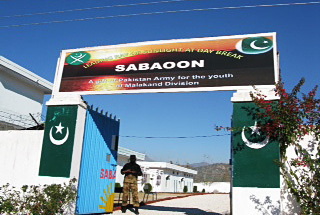Trigger warning: violence against children
Situated 130 kilometres from the Pakistani capital of Islamabad, the Swat Valley has oftentimes been regarded as the ‘Switzerland of Asia’. From 2007-2009, however, this district of approximately 2.3 million inhabitants was the site of one of the most intense military confrontations between the national government and Tehreek-e-Taliban-e-Pakistan (TTP), a collection of armed insurgent groups more commonly known as the Pakistani Taliban. Today, the Swat Valley embodies a state of relative, albeit tenuous, peace. Markets and restaurants now bustle with activity and schools destroyed by fighting across the valley have since been rebuilt; nonetheless, the shadow of the Pakistani military still looms, a consistent reminder of the fragility of peace in this contested territory.
Central to ensuring the sustainability of peace in Swat have been efforts targeting the valley’s youngest generations. Historically, children and adolescents formed a key component of the TTP’s capacity for violence, serving as informants, fighters, and sometimes suicide bombers. The Swat Valley is therefore home to an organisation unique in its focus on rehabilitating the psychological and emotional wounds experienced by youth jihadists: the Sabaoon Centre. The philosophy of Sabaoon, meaning ‘morning light’ in Pashto, is rooted in an understanding of its participants not as violent combatants but, in the words of its director:
‘Teenagers, for heaven’s sake. … They’re children in the end.’
Feriha Peracha, Pakistan Bids To Change The Minds Of Swat Radicals
In contrast to other deradicalisation programmes, the emphasis of the Sabaoon Centre is not simply to provide political or theological counter-narratives to those adopted by violent extremist organisations. The focus is, instead, placed on simply teaching young people how to think.
Peace and Complexity: An Inextricable Link?
My research into the contributions of behavioural psychology to the field of peacebuilding and conflict-prevention revealed a common flaw in attempts to integrate both disciplines – namely, the lack of metrics with which to evaluate the absence of the cognitive drivers of conflict. One proposed framework is that of integrative complexity (IC), a measure of one’s ability to differentiate and integrate multiple perspectives on issues. IC is quantified on a one-to-seven scale, with lower values indicating a propensity for polarising, binary thinking and a resulting increased propensity for conflict.

It is precisely this level of cognitive complexity that the Sabaoon Centre seeks to develop in its participants. Through a four-stage process, the centre’s educators and psychologists begin by exploring social and cultural dilemmas that are likely to provoke low complexity responses within the group; rather than directly attacking these views, however, the programme’s focus subsequently shifts to examining and addressing the values and emotions which underpin these views through group discussions. In doing so, participants become not only increasingly aware of the malleability of their own cognitive perspectives but also more amenable to mutual understandings.
Though specifically applied to the context of violent extremism, the Sabaoon Centre’s core focus on cognitive complexity is equally applicable to broader understandings of peace and wider efforts to promote and sustain it. Just as complex narratives are central to the process of deradicalisation, so too are they in the wider discipline of peacebuilding. Whether examining the ideology of the Pakistani Taliban or the narrative justifications employed to justify the Rwandan Genocide, these and other highly simplified narratives leverage linear storytelling and clear in/out-group distinctions to serve as potent drivers of polarisation and conflict. For the Sabaoon Centre, however, peace and complexity are inextricably tied to one another, with complex narratives populating a landscape in which individual and group perspectives do not compete for dominance but are, instead, interlinked. It this notion of narrative connections and interdependence, operationalised through integrative complexity interventions, that lays at the heart of the Sabaoon Centre’s mission of ensuring a sustainable peace in Swat.
What Do You Think?
- How do you view the relationship between peace and narrative?
- Can you think of some simple, linear narratives you have heard recently, and compare them with some more complex ones? What impact do these different kinds of storytelling have on you, both cognitively and emotionally?
- Does this item prompt you to reflect on the kinds of stories that you tell (complex or simple, look at multiple perspectives or taking one particular stance, etc) as well as on the stories that you are told?
- Can you imagine a circumstance in which a complex individual or group narrative may, in fact, serve as a hindrance to peace?
- Do you feel this emphasis on leveraging psychological insights excludes other factors central to successful peacebuilding efforts?
If you enjoyed this item in our museum…
You might also enjoy ‘Moral Injury: Healing‘, ‘Intergroup Contact Theory‘, ‘Education: a force for sustainable peace‘, and ‘Achilles in Vietnam‘.
Mathias Katsuya, April 2023